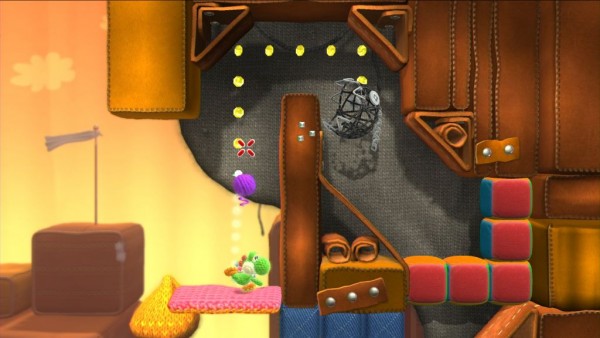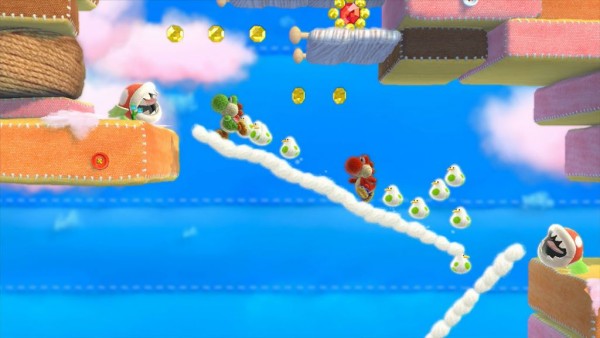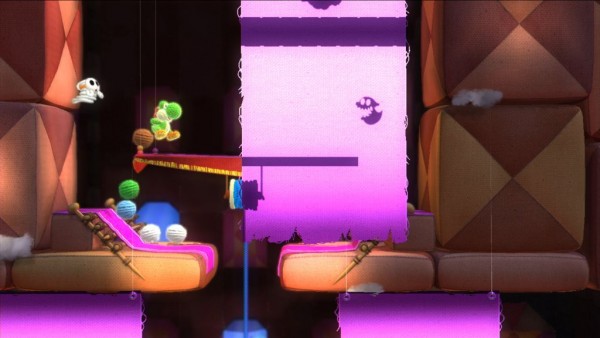Publisher: Nintendo
Developer: Good-Feel
Medium: Digital/DVD
Players: 1-2
Online: No
ESRB: E – Everyone
In regards to sequels, it’s easy to see a sophomore effort become a sort of third wheel in the happy relationship of player and video game. When it comes to Super Mario World 2: Yoshi’s Island, this was exactly the case for a variety of attempts to revisit the magic conjured up on the SNES in the mid 90’s. Aside from the unfortunately-named Yoshi’s New Island on DS, the series became a point of retirement for originality, creativity, and character, between Yoshi’s Story on Nintendo 64, the experimental Touch & Go on the DS, and an even less memorable follow-up on the 3DS.
For a series with so many third wheels (more precisely a fourth and fifth), it becomes increasingly difficult to capitalize on the success of what went right in the first place. Certainly, Yoshi’s New Island demonstrated that by doing things almost exactly as they had been done originally, a recipe for success existed, but in the interest of avoiding stagnation, something would eventually have to change in a way that benefits both the game and also its audience.
Yoshi’s Woolly World proposes simplicity to be a starting point for moving onward, with a visual redesign to communicate change in at least more ways than one. Most notably on the list of omissions are any baby versions of Nintendo characters that Yoshi temporarily adopted in past adventures, meaning that players are relieved of a game-long escort mission which may or may not be crying just out of reach, depending on their luck. With no children to rescue, it’s the Yoshi clan itself in trouble this time, as series-loyal villain Kamek has turned all but two Yoshi into balls of yarn for something dubious. Obviously, this can’t be allowed, and the game begins.
Anyone playing Nintendo games recently will find may habits in order with Yoshi’s Woolly World, from the minimal and succinct story, to a more confident sense of humor about the game itself. In the case of Woolly World, the team seems to have developed a great affection for the yarn-themed world they’ve fabricated, with Yoshi turning enemies into balls of yarn rather than eggs, and a playful twist on the inner-workings of everyday platforming elements (such as clouds supported by string, enemies unraveling as they’re eaten, and water represented by a few stray lines gliding on different planes). These elements are critical for Woolly World, just as they were in Kirby Rainbow Curse, where arresting visuals are fully incorporated into the game’s design — building a world where more careless creators would leave them on display as window dressing.
While Nintendo are no strangers in giving attention to detail, the matter of being distracted from other areas can come into question if the final result is somewhat lopsided. While the truth of the matter is unclear, it does seem that a tremendous amount of care was given to the presentation in Woolly World, whereas the game itself is assumed to ride on the coattails of any visual success. This isn’t to call Woolly World droll by any means, but with such inventive aesthetics, the game’s design is doomed to bring new ideas of its own or meet the consequence of seeming uninspired by comparison (aside from the case of re-imagined Chomps, where art direction meshes nicely with enemy patterns and puzzle-solving).
Following the aforementioned rule of simplicity, Woolly World is structured around the core mechanics of hopping around levels in search of collectibles and secrets until having reached the end. Balls of yarn replace eggs, as mentioned, serving the same function of ammunition against enemies and obstacles. With no infant on Yoshi’s back, taking damage is the only repercussion players will face. Whether this previously-included secondary means of failure was an identifying factor in the Yoshi’s Island philosophy, no measures were taken to retain it in a direct or surrogate fashion, for better or worse. While I didn’t miss running after a crying baby, it was clear that the sense of risk is less present in Woolly World, and along with it any urgency in dangerous situations.
Woolly World is challenging enough to remain engaging, but a stroke of brilliance sat in the baby-shaped shadows of Yoshi’s past, where the jumping and fluttering about served as moments of platforming precision, showcasing core mechanics in their best light. Certainly, there were a fair share of insufferable and frustrating bits born of losing Baby Mario, but a majority’s share highlighted the fitting together of inspired mechanics above even most boss fights.
In Yoshi’s Woolly World, the closest the game comes to realizing it doesn’t need to be anchored to its past comes in the form of different uses for things that can be thrown. Most notably, the cloud streams that can be formed by throwing white chicks are an inventive feature used maybe twice, whereupon the path of each toss creates a temporary platform for general use. Other highlights pull from mechanics we’ve seen in Mario titles, with platforms unfolding based on player interaction, or silhouettes dividing two planes of existence. For the rest of the game, the basic gameplay of Yoshi’s Island is prevalent, with plenty of yarn-throwing and fluttery jumps in getting from point A to B.
Another disappointing note is that the boss fights lack any of the invention seen in the original Yoshi’s island. Understandably, a series shouldn’t venture too far from the path it’s laid, but back on the SNES, Yoshi’s Island was a cornerstone of experimentation from the moment its squiggly lines came onscreen. Woolly World is more of a tribute to past success than it is confident that its own ideas would succeed, and if there’s anything to criticize it for, it would mostly be the cautionary approach to delivering a decent memory of a beloved series than moving onward towards what sort of life it could continue to have. At this rate, it’s counterproductive to release any more games in the vein of Yoshi’s Island unless the idea is to outlive nostalgia.
Ironically, where Mario games were once exhausting what could be done in a 2D space (likely inspiring Yoshi’s Island for variety, at least), they’ve found new life in a 3D space. If Woolly World followed the philosophies laid out in Mario 3D World, for instance, we’d see a game filled with more creativity and well-explored one-off ideas per world than the original game premiered on the whole. It’s not the tried-and-true design that disappoints in Woolly World, but the rare highlight that reminds of of what’s missing overall.
And so, simplicity takes two steps back before putting at least one forward with Woolly World, as its mainly basic use of Yoshi’s abilities end up delivering an experience that’s more suited to a prequel — before any of this Nintendo baby madness came into play. This is Yoshi before he came into being a foster parent, when his adventures were more straightforward, with less complicated design and ambition, serving as more of a test bed for some interesting game mechanics that a team wanted to see fleshed out a bit. In a sequel, that’s where Yoshi would become a hero to others than his own (maybe a future mascot) — where better use of friendly allies would be exhibited, boss fights would have an identity, and a general sense of confidence would accompany a return to form.
I’m entirely pleased with what Yoshi’s Woolly World has accomplished, in regards to delivering a complete and well-designed Yoshi’s Island game, but much is lost in the goal of recreating the past. While Artoon showed that that a sequel can be strong if it’s by-the-books, it’s disappointing to see Good-Feel unaware of what else to do besides revise the art direction and remove a controversial element of baby characters. There’s a lot to like in Woolly World, but almost just as much to remind us that we’ve seen this all before (aside from a world of yarn, that is).





